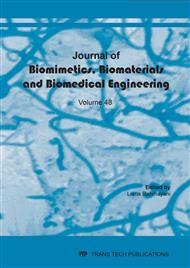[1]
Khanna G, Aparna IN. Comparison of microhardness of three different types of acrylic artificial denture teeth: in vitro study. J Orofac Res 2013; 3 (3): 181-5.
Google Scholar
[2]
Anusavice KJ, Shen C, Rawls HR. Philips science of dental materials. 12th ed. India: Elsevier 2012: 99-100.
Google Scholar
[3]
Nandal S, Ghalaut P, Shekhawat H, et al. New era in denture base resins: A review. DJAS 2013; 1 (3): 136-43.
DOI: 10.1055/s-0038-1671969
Google Scholar
[4]
Sundari I, Pocut AS, Millati H. Studi Kekuatan Fleksural Antara Resin Akrilik Heat Cured Dan Termoplastik Nilon Setelah Direndam Dalam Minuman Kopi Uleekareng (Coffea Robusta). J Syiah Kuala Dent Soc 2016; 1(1): 51-8.
DOI: 10.24815/cdj.v11i1.13631
Google Scholar
[5]
Prabowo A, Paulus BT, Dwi A. Perbedaan Efektivitas Ekstrak Daun Mangrove Acanthus Ilicifolius Dengan Sodium Bikarbonat 5% Terhadap Penurunan Jumlah Koloni Candida Albicans Pada Perendaman Nilon Termoplastik. Denta jkg 2015; 9(2): 198-200.
DOI: 10.30649/denta.v9i2.25
Google Scholar
[6]
Kohli S, Bhatia S. Poliamide in dentistry. IJSS 2013; 1(1): 20-5.
Google Scholar
[7]
Ali AM, Raghdaa KJ. Evaluation and comparison of the effect of repeated microwave irradiations in some mechanical and physical properties of heat cure acrylic resin and valplast (nylon) denture base material. J Bagh Coll Dentistry 2011; 23 (3): 6-10.
Google Scholar
[8]
Fueki K, Ohkubo C, Yatabe M, Arakawa I, Arita M, Ino S, dkk. Clinical application of removable partial dentures using thermoplastic resin – Part I: Definition and indication of non-metal clasp dentures. J Prosthodont Res 2014; 58: 3-10.
DOI: 10.1016/j.jpor.2013.12.002
Google Scholar
[9]
Mekkawy MA, Hussein LA, Alsharawy MA. Comparative study of surface roughness between polyamide, thermoplastic polymethyl methacrylate and acetal resins flexible denture base materials before and after polishing. Life Sci J 2015; 12 (10): 90-5.
Google Scholar
[10]
Shah J, Bulbule N, Kulkarni S, Shah R, Kakade D. Comparative evaluation of sorption, solubility and microhardness of heat cure polymethylmethacrylate denture base resin & flexible denture base resin. JCDR 2014; 8 (8): 1-4.
DOI: 10.7860/jcdr/2014/8707.4770
Google Scholar
[11]
Tenripada N, Wahyuningtyas E, Sugiatno E. Pengaruh derajat keasaman saliva terhadap modulus elastisitas termoplastik nilon dan polikarbonat sebagai bahan basis gigi tiruan. J Ked Gi 2014; 5 (4): 336-41.
DOI: 10.33854/jbd.v1i1.296
Google Scholar
[12]
Nasution H, Kamonkhantikul K, Arksornnukit M, et al. Pressure transmission area and maximum pressure transmission of different thermoplastic resin denture base materials under impact load. J Prosthodont Res 2018; 62 (1): 44-9.
DOI: 10.1016/j.jpor.2017.05.001
Google Scholar
[13]
Utami M, Febrida R, Djustiana N. The Comparison Of Surface Hardness Between Thermoplastic Nylon Resin And Heat-Cured Acrylic Resin. PJD 2009; 21(3): 200-3.
DOI: 10.24198/pjd.vol21no3.14117
Google Scholar
[14]
Hamanaka I, Misa I, Lippo VJL, Pekka KV, Yutaka T. Wear resistance of injection-molded thermoplastic denture base resins. Acta Odontol Scand 2016; 2: 31-7.
DOI: 10.3109/23337931.2015.1135747
Google Scholar
[15]
Callister WD, Rethwisch DG. Material science and engineering. 8th ed. USA: Wiley, (2010).
Google Scholar
[16]
Fueki K, Ohkubo C, Yatabe M, Arakawa I, Arita M, Ino S, et al. Clinical application of removable partial dentures using thermoplastic resin-Part II: material properties and clinical features of non-metal clasp dentures. J Prosthodont Res 2014; 58: 71-84.
DOI: 10.1016/j.jpor.2014.03.002
Google Scholar
[17]
Nasution H, Arksornnukit M. PMMA demonstrated higher elastic modulus and nanohardness compared with polyamide denture base materials. Key Eng Mater 2017; 751: 643-8.
DOI: 10.4028/www.scientific.net/kem.751.643
Google Scholar
[18]
Biotone, Denken-Highdental Co., Ltd., Kyoto, Japan. http://www.kdf.co.jp/english/ materials/m05/m05_4 . (15 Juni 2019).
Google Scholar
[19]
Vojdani M, Giti R. Polyamide as a denture base material: A literature review. J Dent 2015; 16 (1): 1-9.
Google Scholar


